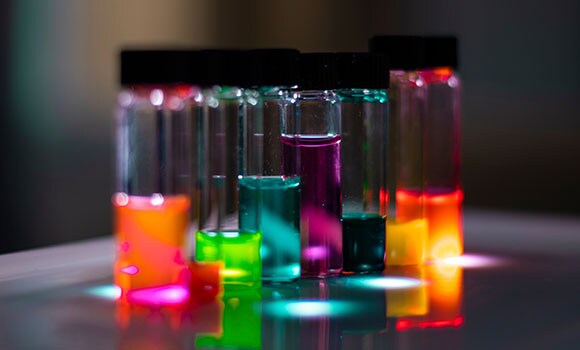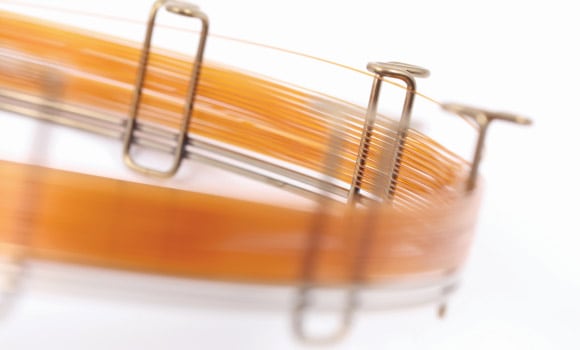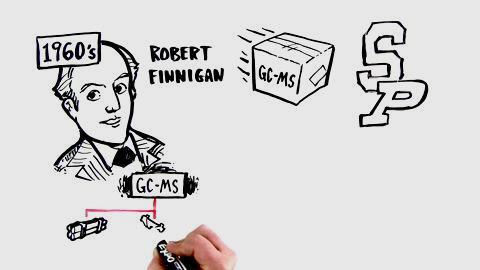Search

GCMS气相色谱质谱联用仪原理
GC-MS气相色谱质谱联用仪原理决定了其可用于研究液体,气体或固体样品。分析始于气相色谱仪,其中样品被有效汽化到气相并使用包被固定 (液体或固体) 相的毛细管柱将其分离到不同组分中。化合物由惰性载气推进,如氦,氢或氮。分离混合物的组分时,每种化合物根据其沸点和极性在不同的时间从色谱柱中洗脱。洗脱时间称为化合物的保留时间。GC 能够分辨含有数百种化合物的复杂混合物或样品提取物。
一旦这些组件离开 GC 色谱柱,它们就会被质谱仪使用电子或化学电离源进行电离和裂解。然后,通过仪器的质量分析仪加速离子化分子和碎片的加速,这通常是四极杆或离子阱。在此,离子根据其不同的质荷 比 ( m/z ) 进行分离。GC-MS 数据采集可在全扫描模式下进行,以覆盖广泛的 m/ z比率 或选择的离子监测 (SIM) 模式,以收集特定目标质量的数据。
GCMS实验过程的最后一步涉及离子检测和分析,碎片化的离子显示为其 m/z 比的函数。同时,峰面积与相应化合物的数量成比例。当通过 GC-MS 分离复杂样品时,它将在气体色谱图中产生多个不同的峰,并且每个峰生成一个用于化合物鉴别的独特质谱。使用广泛的市售质谱库,可以对未知化合物和目标分析物进行鉴别和定量。
GC-MS 的类型和何时使用
不同的分析任务需要不同的检测能力。虽然气相色谱系统可能保持相同状态,但根据所需的选择性和灵敏度,可能需要不同类型的质谱仪进行不同类型的分析。
单四极杆GC-MS
当气相色谱法与仅包括一个四极杆的质谱仪配合使用时,通常被称为 GC-MS气相色谱质谱法。GC-MS气相色谱质谱法 非常适合需要靶向或非靶向分析的样品的日常分析,因为这些系统可以使用靶向选择离子监测 (SIM) 或非靶向全扫描采集来操作。典型应用包括食品和环境样品中的农药分析,违禁药物分析和水样中挥发性有机化合物的分析。
三重四极杆GC-MS/MS
气相色谱分析与三重四极杆质谱系统的结合称为 GC-MS/MS。三重四极杆 MS 提供更高水平的选择性,非常适合需要极高灵敏度的分析。当对食品或环境污染物中的农药进行定量时,通常会发生这种情况。GC-MS/MS 系统通常以选择性反应监测 (SRM) 模式运行。SRM 的高选择性有助于减少背景离子的干扰,并产生高信噪比,以实现出色的检测能力。
HRAM GC-MS/MS
为了在一次分析中通过高可靠性化合物发现,鉴别和定量对样品进行全面表征, GC 系统可与高分辨率精确质量 (HRAM) 质谱仪结合使用。这些 GC-MS/MS 系统能够提供三重四极杆 GC-MS/MS 的定量能力,结合仅从极灵敏和准确的质谱仪中获得的高精度,全扫描 HRAM 功能。这些系统非常适用于需要准确的靶向分析和可靠的未知化合物鉴别的应用。
样本制备

气相色谱柱

GC气相色谱柱代表气相色谱分析的固定相和分离工具。固定相确保不同化合物在不同时间从色谱柱中充分分离和洗脱。具有不同固定相的不同类型的色谱柱可用于不同应用,例如测定挥发性有机化合物 (VOC) 或二噁英。它们可设计用于分离极性或非极性化合物或以不同速度处理样品。色谱柱不能释放固定相化合物,因此在得到的色谱图中提供最小的背景信号,有时被称为 " 低流失 "。GC 色谱柱材料的惰性也是考虑到以防止与样品发生不必要的化学相互作用的关键因素。
要了解有关 Thermo Fisher Scientific 提供的不同类型 GC 色谱柱的更多信息,请访问我们的气相色谱柱页面或下载色谱耗材目录 - GC 色谱柱和附件。
GC-MS应用
从食品中的潜在毒性化学品检测到定量分析水中的有机污染物或者在油加工过程中石油产品的分析, GC-MS气相色谱质谱法可用于多种应用。查看以下各节,了解一些使用这些系统时最常见的分析。
食品&饮料分析
GC-MS气相色谱质谱法分析对于确保我们食用和饮料的食品的安全和真实性至关重要。从农药残留测定到成分表征,GC-MS气相色谱质谱联用仪 系统为制造商和监管机构提供有关我们食品供应安全的宝贵信息。
环境分析
GC-MS气相色谱质谱法是监测空气,水和土壤中污染物的强大工具。对于挥发性有机化合物 (VOC) 和半挥发性有机化合物 (SVOC) ,多氯联苯 (PCB) ,有机氯农药,溴化阻燃剂和多环芳香烃 (PAH) 的定量来说尤其有用。
代谢组学
GC-MS气相色谱质谱法提供了复杂代谢组学分析所需的一些复杂分析技术。GCMS气相色谱质谱联用仪让研究人员深入探索代谢组,并获得完整的代谢物覆盖范围,以支持植物,动物和微生物中的一级和二级代谢物研究。如以下应用所示,HRAM GC-MS 特别适合分析非靶向代谢物鉴别的挑战。
油气分析
GC-MS气相色谱质谱法可用于石油和天然气检测工作流程的许多阶段,用于测定能量含量, CHA , SIMDIS ,天然气和天然气凝物的 H2S / 有机硫含量。此外, GC-MS气相色谱质谱法分析可用于炼厂气分析 (RGA) 和详细碳氢化合物分析 (DHA) ,以检测原油中的含氧化合物,芳香族化合物, BTEX 化合物和 PAH。
访问我们的分析和生命科学网络研讨会页面
聆听行业专家分享他们对最新技术、应用程序和工作流程的见解,帮助您的实验室保持最新状态。这些直播和点播式的网络研讲座包含GCMS气相色谱质谱联用仪原理及应用等信息,可以提高您实验室的生产力,保持其合规性,并了解不断发展的科学环境,无论您是在实验室还是在家中工作。
想了解更多关于GC-MS产品的信息?
Thermo Fisher Scientific 提供全系列 GC-MS 系统,色谱柱和耗材。要了解有关我们稳健,可靠的GCMS气相色谱质谱联用仪原理及气相色谱质谱产品的更多信息,请访问我们的气相色谱分析 - 质谱分析页面。

















